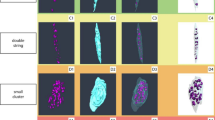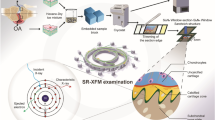Abstract
For studies on matrix mineralization in osteoarthritis (OA), a clear analytical approach is necessary to identify and to quantify mineralization in the articular cartilage. The aim of this study is to develop an effective algorithm to quantify and to identify cartilage mineralization in the experimental setting. Four patients with OA of the knee undergoing total knee replacement and four control patients were included. Cartilage calcification was studied by digital contact radiography (DCR), field emission scanning electron microscopy (FE-SEM) X-ray element analysis and Raman spectroscopy (RS). DCR revealed mineralization in all OA cartilage specimens. No mineralization was observed in the control cartilage. Patient I showed rhomboid shaped crystals with a mean Ca:P molar ratio of 1.04 indicated the presence of calcium pyrophosphate dihydrate (CPPD) crystals, while Patients II, III and IV presented carbonate-substituted hydroxyapatite (HA). RS also showed the presence of CPPD crystals in Patient I while Patients II, III and IV revealed spectra confirming the presence of HA crystals. In the corresponding chondrocyte cell culture analyzed with SEM, the presence of CPPD crystals in the culture of Patient I and HA crystals in the culture of Patient II, III and IV was confirmed. No mineralization was found in the cell culture of the controls. The differentiation between BCP and CPPD crystals plays an important role, and the techniques presented here provide an accurate differentiation of these two types of crystals. For quantification of articular cartilage mineralization, DCR is a simple and accurate method.




Similar content being viewed by others
References
Ryan LM, McCarty DJ (1997) Calcium pyrophosphate crystal deposition disease, pseudogout and articular chondrocalcinosis. In: Koopman WJ (ed) Arthritis and allied conditions, 13th edn. Wiliams &Wilkins, Baltimore, pp 2103–2105
Yavorskyy A, Hernandez-Santana A, McCarthy G, McMahon G (2008) Detection of calcium phosphate crystals in the joint fluid of patients with osteoarthritis—analytic approaches and challenges. Analyst (Lond) 133:302–318. doi:10.1039/b716791a
Derfus BA, Kurian JB, Butler JJ, Daft LJ, Carrera GF, Ryan LM, Rosenthal AK (2002) The high prevalence of pathologic calcium crystals in preoperative knees. J Rheumatol 29:570–573
Halverson PB, McCarty DJ (1986) Patterns of radiographic abnormalities associated with basic calcium phosphate and calcium pyrophosphate dihydrate crystal deposition in the knee. Ann Rheum Dis 45:603–605. doi:10.1136/ard.45.7.603
Nalbant S, Martinez JA, Kitumnuaypong T, Clayburne G, Sieck M, Schumacher HR Jr (2003) Synovial fluid features and their relations to osteoarthritis severity: new findings from sequential studies. Osteoarthritis Cartilage 11:50–54. doi:10.1053/joca.2002.0861
Boivin G, Lagier R (1983) An ultrastructural study of articular chondrocalcinosis in cases of knee osteoarthritis. Virchows Arch 400(1):13–29. doi:10.1007/BF00627005
Halverson PB, Cheung HS, Johnson R, Struve J (1998) Simultaneous occurrence of calcium pyrophosphate dihydrate and basic calcium phosphate (hydroxyapatite) crystals in a knee. Clin Orthop Relat Res 257:162–165
McCarty DJ, Lehr JR, Halverson PB (1983) Crystal populations in human synovial fluid. Identification of apatite, octacalcium phosphate and tricalcium phosphate. Arthritis Rheum 26:1220. doi:10.1002/art.1780261008
Grynpas MD, Omelon S (2007) Transient precursor strategy or very small biological apatite crystals? Bone 41:162–164. doi:10.1016/j.bone.2007.04.176
Daculsi G, LeGeros RZ, Mitre D (1989) Crystal dissolution of biological and ceramic apatites. Calcif Tissue Int 45(2):95–103. doi:10.1007/BF02561408
Derfus B, Kranendonk S, Camacho N, Mandel N, Kushnaryov V, Lynch K, Ryan L (1998) Human osteoarthritis cartilage matrix vesicles generate both calcium pyrophosphate dihydrate and apatite in vitro. Calcif Tissue Int 63(3):258–262. doi:10.1007/s002239900523
Johnson K, Moffa A, Chen Y, Pritzker K, Goding J, Terkeltaub R (1999) Matrix vesicle plasma cell membrane glycoprotein-1 regulates mineralization by murine osteoblastic MC3T3 cells. J Bone Miner Res 14:833–892. doi:10.1359/jbmr.1999.14.6.883
Gajjeraman S, Narayanan K, Hao J, Qin C, George A (2007) Matrix macromolecules in hard tissue control the nucleation and hierarchical assembly of hydroxyapatite. J Biol Chem 282(2):1193–1204
Jung A, Bisaz S, Fleisch H (1973) The binding of pyrophosphate and two diphosphonates by hydroxyapatite crystals. Calcif Tissue Res 11:269–280. doi:10.1007/BF02547227
Meyer JL, Nancollas GH (1973) The influence of multidentate organic posphonates on the crystal growth of hydroxyapatite. Calcif Tissue Res 13:295–303. doi:10.1007/BF02015419
Russell RGG, Bisaz S, Fleisch H, Currey HL, Rubinstein HM, Dietz AA, Boussina I, Micheli A, Falet G (1970) Inorganic pyrophosphate in plasma, urine, and synovial fluid of patients with pyrophosphate arthropathie (chondrocalcinosis or pseudogout). Lancet 2:899–902. doi:10.1016/S0140-6736(70)92070-2
Ho A, Johnson M, Kingsley DM (2000) Role of mouse ANK gene in tissue calcification and arthritis. Science 289:265–270. doi:10.1126/science.289.5477.265
Williams CJ, Zhang Y, Timms A, Bonavita G, Caeiro F, Broxholme J et al (2002) Autosomal dominant family calcium pyrophosphate dihydrate deposition disease is caused by mutation in the transmembrane protein ANKH. Am J Hum Genet 71:985–991. doi:10.1086/343053
Hirose J, Ryan LM, Masuda I (2002) Up-regulated expression of cartilage intermediate-layer protein and ANK in articular hyaline cartilage from patients with calcium pyrophosphate dihydrate crystal deposition disease. Arthritis Rheum 46:3218–3229. doi:10.1002/art.10632
Mandel GS, Halverson PB, Rathburn M, Mandel NS (1990) Calcium pyrophosphate crystal deposition: a kinetic study using a type I collagen gel model. Scanning Microsc 4(1):175–179
McCarthy DJ, Hogan JM, Gatter RA, Grossman M (1966) Studies on pathological calcifications in human cartilage. J Bone Joint Surg 48:309–325
Mitsuyama H, Healey RM, Terkeltaub RA, Coutts RD, Amiel D (2007) Calcification of human articular knee cartilage is primarily an effect of aging rather than osteoarthritis. Osteoarthritis Cartilage 15(5):559–565. doi:10.1016/j.joca.2006.10.017
Acknowledgments
His work was supported by “Deutsche Arthrosehilfe e.V”, Neue-Welt-Str. 4-6, 66740 Saarlouis, Germany grant nr: p77-a117-Rüther-EP2-fuer1-knie-ko—49 k-2006-7
Author information
Authors and Affiliations
Corresponding author
Rights and permissions
About this article
Cite this article
Fuerst, M., Lammers, L., Schäfer, F. et al. Investigation of calcium crystals in OA knees. Rheumatol Int 30, 623–631 (2010). https://doi.org/10.1007/s00296-009-1032-2
Received:
Accepted:
Published:
Issue Date:
DOI: https://doi.org/10.1007/s00296-009-1032-2




